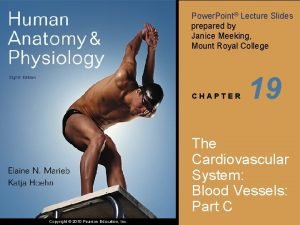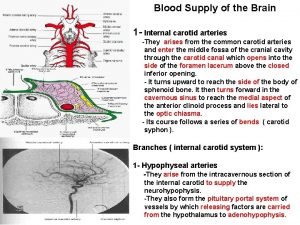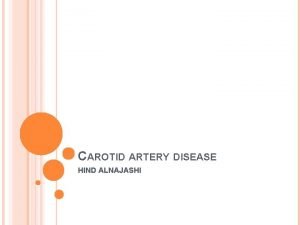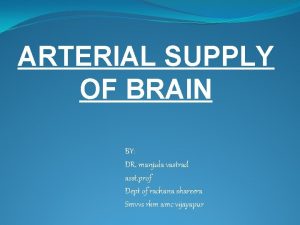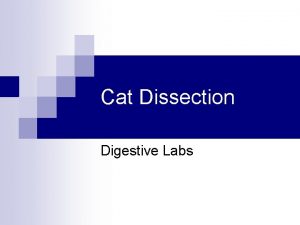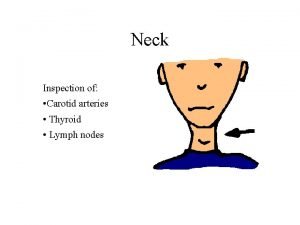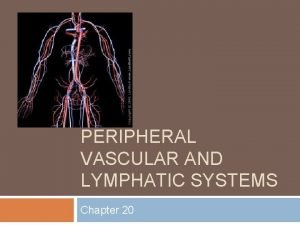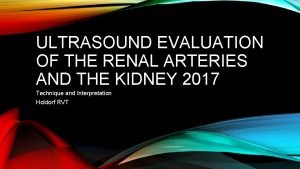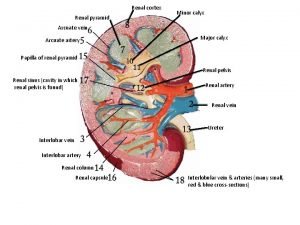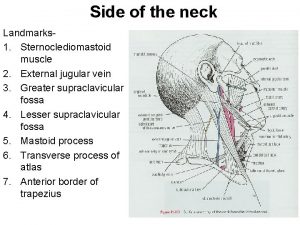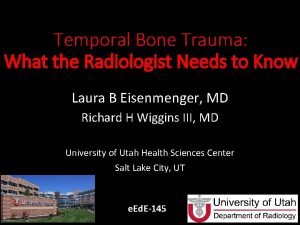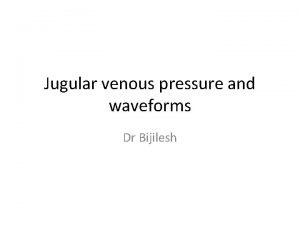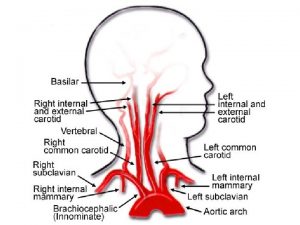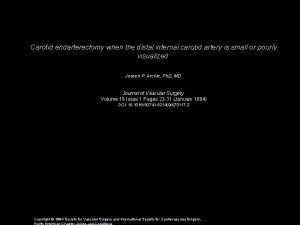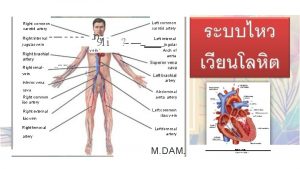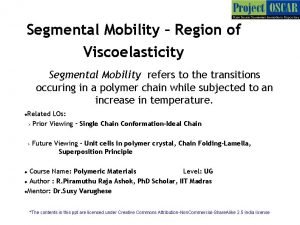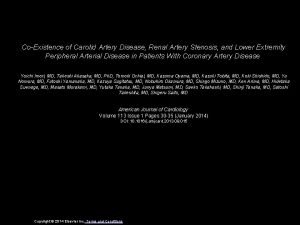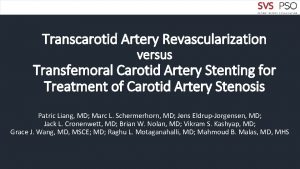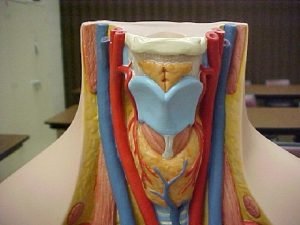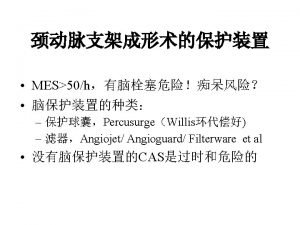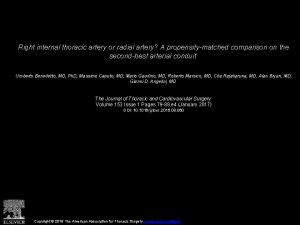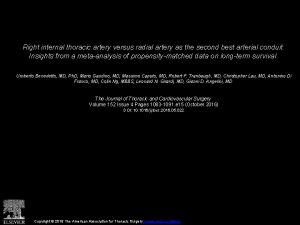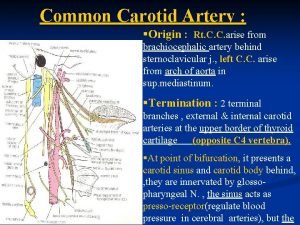Segmental Artery Mediolysis Involving the Internal Carotid Artery



















- Slides: 19

Segmental Artery Mediolysis Involving the Internal Carotid Artery: An Uncommon Diagnosis Electronic Excerpta Poster #: EE-06 Control #: 1350 Daniel A. Adamo, MD Jonathan M. Morris, MD Department of Radiology, Mayo Clinic - Rochester American Society of Neuroradiology Washington, DC 5/23/2016

Disclosures • No financial or other conflicts of interest to disclose

Purpose • To review the clinical and imaging features of segmental arterial mediolysis (SAM). • Identify the complications of SAM • Understand the radiologists role in diagnosis and therapy of SAM

Case Report • 53 year old female presented to her local emergency department for severe epigastric and left upper quadrant pain • CT of the abdomen showed a splenic infarction • Further workup with CTA of the abdomen ordered

Imaging Findings • CTA of the abdomen: Irregular beaded dilatation of the renal arteries, right gastroepiploic, left gastric and left gastroepiploic arteries.

Case Report • Additional consultation with Vascular Medicine and Rheumatology • ANCA – negative • ANA – negative • RF – negative • ESR – 12 mm/hr (normal 0 -29) • CRP – 3 mg/d. L (normal <3)

Case Report • The patient subsequently experienced multiple episodes of tingling and twitching of her right forehead, nose, cheek and eyelid. • An MRI/MRA of the head and neck was obtained to evaluate her neurologic symptoms.

Imaging Findings – MRA of the neck 5 mm pseudo aneurysm in the left ICA Long segment dilation of the right ICA

Imaging Findings – MRA of the neck Focal dissection of the left ICA © 2015 MFMER | slide-9

Imaging Findings – MRA of the head 3 mm supraclinoid pseudoaneurysm of the left ICA

Segmental Artery Mediolysis (SAM) • First described by Slavin and Gonzalez-Vitale in 19761 • Idiopathic non-atherosclerotic, non-inflammatory arteriopathy • Characterized by lysis of the medial layer of arterial wall • leads to the imaging features of focal dissection, aneurysm, stenosis or occlusion • Male > Females, 1. 5 : 1 • Typically middle aged to elderly • Almost always over age of 40 2 • Most often involves abdominal vessels, but cranial involvement can be seen

Angiographic Presentation 3 • Arterial Dilatation • Single Aneurysm • Multiple Aneurysms – “string of beads” • Dissecting hematomas • Arterial stenosis • Arterial Occlusion 3. Slavin, R. E. , Segmental arterial mediolysis: course, sequelae, prognosis, and pathologic-radiologic correlation. Cardiovasc Pathol, 2009. 18(6): p. 352 -60.

Histology/Pathology • Injurious Phase –mediolysis/disruption of smooth muscle • Starts in the outer media layer • Can involve the entire medial muscle • Can eventually lead to damage of the internal elsatica and intima • Causes “arterial gaps” which can lead to aneurysms • Large gaps fusiform aneurysms • Smaller gaps saccular aneurysms • Reparative Phase – the medial defects are rapidly repaired by granulation tissue • The healing process can cause stenosis • If the injury involved the intima, reparative granulation tissue fills the intimal injury forming a plaque • This is thrombogenic – can lead to occlusion or embolism 3. Slavin, R. E. , Segmental arterial mediolysis: course, sequelae, prognosis, and pathologic-radiologic correlation. Cardiovasc Pathol, 2009. 18(6): p. 352 -60.

Vascular Distribution A review of the literature by Shenouda et al decribed 85 cases of SAM 4 Territories Involved Celiac axis and branches SMA and branches IMA and branches n = 85 47 (55%) 32 (38%) 11 (13%) Cranial/Cerebral arteries 15 (18%) • • • 9 (11%) 7 (8%) 2 (2%) 1 (1%) Internal Carotid Vertebral Basilar Anterior Cerebral Anterior Communicating Superficial Temporal 4. Shenouda, M. , et al. , Segmental arterial mediolysis: a systematic review of 85 cases. Ann Vasc Surg, 2014. 28(1): p. 269 -77.

Differential Diagnosis Medium vessel vasculitis • Unlike vasculitis, SAM does not have elevated inflammatory and immune markers such as ESR, CRP, ANA, ANCA Cystic Medial Necrosis • typically involves larger arteries, often seen in Marfan’s Cystic Adventitial Artery Disease • involves extremities of younger adults Fibromuscular Dyplasia 5. Chao, C. P. , Segmental arterial mediolysis. Semin Intervent Radiol, 2009. 26(3): p. 224 -32.

SAM vs FMD • Significant histologic overlap • However clinical presentations are distinct • Chicken or egg? • SAM may be an evolutionary precursor to FMD 6 • Some authors argue visa versa 7 6. Slavin RE, Saeki K, Bhagavan B, Maas AE. Segmental arterial mediolysis: a precursor to fibromuscular dysplasia? Mod Pathol 1995; 8(3): 287– 294 7. Hall, E. T. , et al. , Segmental arterial mediolysis and fibromuscular dysplasia: what comes first, the chicken or the egg? Cardiovasc Pathol, 2016. 25(2): p. 113 -5.

SAM vs FMD SAM FMD • Typically older • Patients typically younger • More common in men • More common in women • More often involves abdominal splanchnic arteries • More often involves renal and carotid arteries • Often presents with aneurysmal hemorrhage • Rarely ruptures © 2015 MFMER | slide-17

Treatment of SAM • No definitive treatment • Therapies are targeted at prevention of hemorrhage and other complications • Medical therapy • Antihypertensives help to prevent complications(Steroids and immunosuppressants are ineffective and may have adverse outcomes 8 • Coiling of aneurysms is effective to prevent hemorrhage 9, 10 • Surgical options have been reported involving the internal carotid 11 8. Lie, J. T. , Systemic, cerebral, and pulmonary segmental mediolytc arteriopathy: Villainous masqueraders of vasculitis. Cardiovasc Pathol, 1996. 5(6): p. 305 -14. 9. Shimohira, M. , et al. , Transcatheter arterial embolization for segmental arterial mediolysis. J Endovasc Ther, 2008. 15(4): p. 493 -7. 10. Ryan, J. M. , P. V. Suhocki, and T. P. Smith, Coil embolization of segmental arterial mediolysis of the hepatic artery. J Vasc Interv Radiol, 2000. 11(7): p. 865 -8. 11. Obara, H. , et al. , Reconstructive surgery for segmental arterial mediolysis involving both the internal carotid artery and visceral arteries. J Vasc Surg, 2006. 43(3): p. 623 -6.

Summary • SAM is a non-immune, non-atherosclerotic arteriopathy characterized by lysis of the tunica media in medium sized vessels • Commonly affects abdominal vasculature, but can affect cranial vessels • Characteristic findings on angiography include aneurysm, dissection, stenosis and occlusion • Significant overlap with FMD, but distinct clinical presentations • Typically presents as hemorrhage in older adults • Coil embolization is a mainstay of therapy to prevent hemorrhage
 Posterior auricular vein
Posterior auricular vein Internal carotid artery branches
Internal carotid artery branches Amurosis fugax
Amurosis fugax Internal carotid artery
Internal carotid artery Fetal pig adrenal gland
Fetal pig adrenal gland Retract defintion
Retract defintion Arteries
Arteries Occipital artery
Occipital artery Ear lymph nodes
Ear lymph nodes Boundaries of anterior triangle
Boundaries of anterior triangle Carotid artery pulse
Carotid artery pulse Segmental artery
Segmental artery Segmental artery
Segmental artery Renal papillae
Renal papillae Superior rectal artery is a branch of
Superior rectal artery is a branch of Mastoid wall of middle ear
Mastoid wall of middle ear Sternoclediomastoid
Sternoclediomastoid Carotid cochlear dehiscence
Carotid cochlear dehiscence V wave cvp
V wave cvp Descending hypoglossi
Descending hypoglossi
